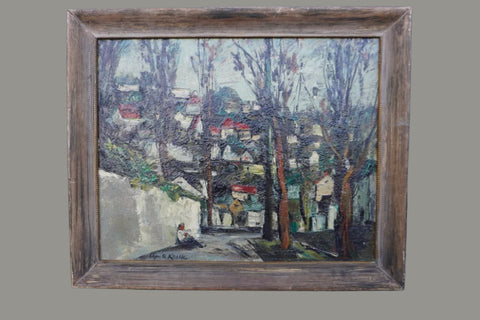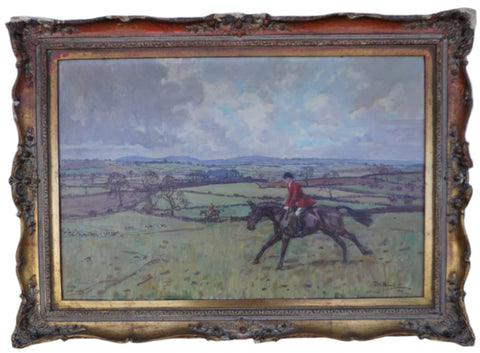Manuel Valencia (1856-1935) - Nocturnal Scene - Oil on Board P3302
A rather magical little painting by a truly pioneering California artist.
Art Measures 9 1/2" x 12" and the frame is 16 1/2" x 16 1/2".
A painter of California history and western landscapes, Manuel Valencia was born in Marin County, California in 1856 on the Rancho San Jose, the Valencia hacienda. The family received many land grants in the San Francisco area because of their ties to settlement history. He was a descendant of General Gabriel Valencia, the first governor of the state of Sonora, Mexico under Spanish rule. He was named for his grandfather, who arrived in California in 1774 and became administrator of the Presidio in San Francisco.
Valencia studied with artists including Jules Tavernier in the San Francisco area, where he lived his entire life, and attended what is now Santa Clara University. He also spent some time in Mexico where he was a member of the Esquela de Bellas Artes de Mexico. Early in his career, he was a commercial artist who designed calling cards. After the 1906 earthquake and fire, Valencia and his family moved to San Jose, but he commuted to his studio in San Francisco. There he was art editor of the "San Francisco Chronicle" newspaper under art patron M.H. de Young, for whom the museum in San Francisco is named. War Cry, the Salvation Army newspaper, also hired Valencia as its first illustrator. During the time he did illustration work in San Francisco, he kept studios in Monterey and Santa Cruz, did landscapes in Tonalist styles including moonlit scenes that were similar to those of Charles Rollo Peters and indicated he had an awareness of the poetic aesthetic of James McNeill Whistler.
Around 1912, he began exhibiting in San Francisco galleries such as S & J Gumps and in New York at Macbeth Gallery and exclusive restaurants such as Delmonico's. President William McKinley, who purchased one of his Yosemite paintings, was amongst his growing list of collectors. He also did desert scenes of Arizona and New Mexico landscapes. He remained in San Francisco until the early 1930s and then moved to Sacramento where he died on July 6, 1935. His family scattered his ashes on Mount Tamalpais in Marin County. In addition to the California capitol, Valencia's work can be seen in the Huntington Art Gallery, San Marino, California; the San Jose Historical Museum; and the Orange County Museum.
Sources:
Carol Lowrey, The Poetic Vision: American Tonalism, (Spanierman Galleries)
Michael David Zellman, Three Hundred Years of American Art
Edan Hughes, Artists in California, 1786-1940














